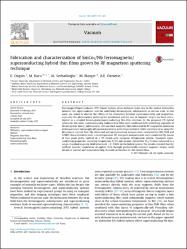Fabrication and characterization of SmCo5/Nb ferromagnetic/superconducting hybrid thin films grown by RF magnetron sputtering technique
Abstract
Ferromagnet/Superconductor (F/S) bilayer hybrids show exclusive states due to the mutual interaction between the superconductor and the underlying ferromagnetic substructures in micron scale. In this work, we aimed to observe the effects of the interaction between superconductivity and magnetism, especially the phenomenon involving the orientation and the size of magnetic stripes has been investigated in a coupled ferromagnetic/superconducting thin-film structure. In the proposed F/S hybrid system by this work, superconducting niobium thin-films were combined with underlying segments of ferromagnetic SmCo5 substructures. 300 nm thick magnetic films fabricated by RF magnetron sputtering techniques were topographically grown in patterns with stripes oriented either transverse to or along the direction of current flow. The elemental and microstructural analyses were conducted by EDX, SEM and GIXRD characterization tools. Low-temperature DC transport measurements were conducted by means of four point probe method in a 9T closed-cycle cryogenic refrigeration system. Transport superconducting properties, transition temperature T-c(H) and second critical field H-C2(T) were measured in a range of applied magnetic field between H = 0-9 kOe for the hybrid system. The results revealed that the artificial periodic modulation of applied field through preferentially-oriented magnetic stripes could introduce normal and superconducting channels or barriers for the current flow. (C)2017 Elsevier Ltd. All rights reserved.


















